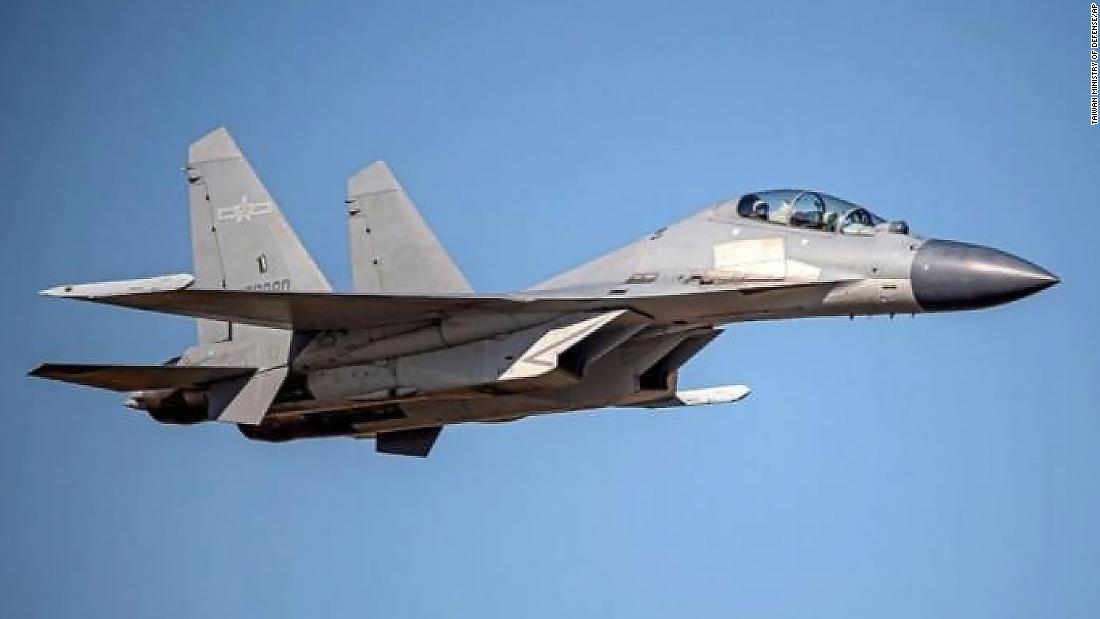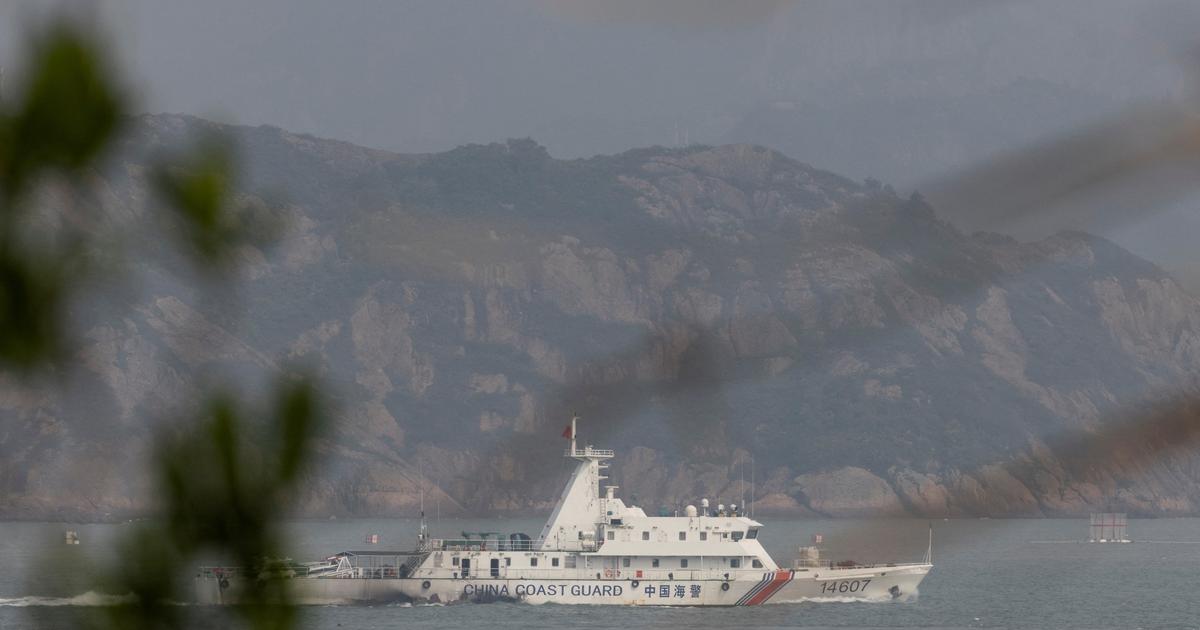China could use military force to control Taiwan 1:57
Hong Kong (CNN) -
China's record number of fighter jets into Taiwan's defense zone in the past four days plays to Beijing's military fortresses as it sends powerful messages both at home and beyond. autonomous, Western analysts say.
A combination of nearly 150 fighter jets, nuclear-capable bombers, anti-submarine aircraft, and control and early warning aircraft from the People's Liberation Army (PLA) Air Force have entered the Taiwan Air Defense Identification Zone (ADIZ). as of Friday, according to the Taiwan Defense Ministry.
While Chinese flights have not come close to what Taiwan considers its sovereign airspace, 12 nautical miles from its shores, they have entered an area, the ADIZ, where Taipei says it will respond to any incursion.
This can be done through radio warnings, anti-aircraft missile tracking, or interceptions of fighter jets.
On Monday, when the PLA Air Force sent the largest number of fighter jets (56) to Taiwan's ADIZ since the island began publicly reporting on such activities last year, the Taiwanese Ministry of Defense said they were issued. radio warnings and air defense missile systems were deployed to monitor activity.
At no point during the surge in Chinese flights was it suggested that actual combat was imminent, but Western analysts say China is capable of scoring multiple points without firing a shot in anger.
advertising
China sends 77 warplanes to Taiwan's defense zone in two days, says Taipei
"This is a well-thought-out program from Beijing, destined to run for months and years, with several interrelated objectives," said Jacob Stokes, a fellow with the Indo-Pacific security program at the Center for a New American Security.
"The first point is the politico-military signaling to try to intimidate the Taiwanese government and exercise China's right to the autonomous island," Stokes said.
"The second is to get PLA pilots and associated military support personnel to have experience conducting these types of operations under different conditions (such as at night), which will increase their combat capability if they are asked to do so. ", said.
"The third is forcing the Taiwanese armed forces to manipulate aircraft in response, which helps to wear down the smaller air force and Taiwan's pilots," Stokes said.
Other analysts say that the People's Liberation Army is also showing friends of Taiwan, specifically the United States, Japan and the United Kingdom, that it will not back down from their support for Taipei.
A military plane crashes in a Texas neighborhood 2:28
They also say that the extensive coverage of the flights in Chinese national media is designed to shore up support for Beijing's campaign to bring Taiwan under its control.
Let's take a look at those five points in relation to the record increase in flights:
What is Taiwan doing that makes China angry?
Taiwan and mainland China have been ruled separately since the end of a civil war more than seven decades ago, in which defeated nationalists fled to Taipei.
However, Beijing views Taiwan as an inseparable part of its territory, despite the fact that the Communist Party of China has never ruled the democratic island of some 24 million people.
And Chinese President Xi Jinping has refused to rule out military force to take back Taiwan if necessary.
Everything you need to know about the dispute between Taiwan and China
According to Lionel Fatton, an Indo-Pacific affairs expert at Webster University in Switzerland, "China needs levers to deter Taiwan from taking undesirable courses of action, especially pro-independence initiatives."
Fatton notes that the increase in Chinese flights to Taiwan's ADIZ came after Taipei officially submitted an application to join the Comprehensive and Progressive Agreement on Trans-Pacific Partnership (CPTPP) free trade pact.
It is the kind of action that Beijing will not tolerate.
"There is only one China in the world and Taiwan is an inalienable part of China's territory. With regard to the CPTPP, we firmly oppose Taiwan's adherence to any official agreement or organization," said the Foreign Ministry spokesman. from China, Lijian Zhao, in a tweet on Sept. 23.
Fatton said the increase in PLA flights is Beijing telling Taipei that it has the means and the firepower to back up that hard-line stance.
It's a classic act of deterrence - showing force before an opponent acts, resulting in unacceptable cost, he said.
Carl Schuster, former director of operations for the US Pacific Command Joint Intelligence Center, said Beijing is signaling to Taipei that it can strike whenever it wants.
"That is a strong message, accompanying and reinforcing China's threatening rhetoric," he said.
And China will be relentless, Fatton said.
CNN Exclusive: "Some are just psychopaths": Chinese detective in exile reveals scale of torture against Uyghurs
"We can expect China to continue its lobbying campaign to make sure its deterrent stance remains strong," he said.
On Tuesday, the president of Taiwan, Tsai Ing-wen, indicated that the island is not about to give way under pressure.
"Amid the almost daily intrusions of the People's Liberation Army, our position on cross-strait relations remains constant: Taiwan will not give in to pressure, but it will not turn reckless, even as it accumulates support from the international community," Tsai wrote in an opinion piece for the US magazine Foreign Affairs.
How does this help China gain military experience?
If Beijing decides on a full military campaign against Taipei, the PLA will need detailed information on the kind of response it will get from the Taiwanese forces.
Sending dozens of fighter jets to Taiwan's ADIZ helps paint that picture for the PLA.
"The PLA is testing and developing an assessment of Taiwan's ability to detect and its willingness to respond to air threats. It is also recording Taiwan's air interception response times, tactics and procedures," Schuster said.
The increasing number of PLA aircraft involved in Taiwan's ADIZ sorties also builds the PLA's ability to work with the large number of military assets that would likely be deployed in combat.
"Coordinated air operations that involve large numbers of aircraft over a great distance are more complicated than operations of small units near the base of operations," said Schuster.
"The air traffic controller's view of the battle space is less accurate at 100 nautical miles than at 10. Adding aircraft increases that complexity."
Schuster said that to his knowledge, the PLA's latest flights represent the largest concentration of Chinese military aircraft ever to have operated so far from their home bases.
So it is possible that large-scale flights will continue.
Essentially, the PLA needs practice.
"The US Air Force and Navy consider (large-scale exercises) routine, but they still train for it at least once a year. The PLA doesn't have that experience," Schuster said.
ANALYSIS |
China says it restricts abortions to promote gender equality.
Experts are skeptical
What about Taiwan's military assets?
Taipei doesn't have as many military aircraft as China, and its fleet is older, too.
If Taipei tries to match the PLA flight for the flight, it will find itself in serious trouble, analysts said.
"Most of Taiwan's fighting force is nearly 30 years old. Every commotion stresses the airframe. As aircraft age, they develop fatigue cracks in their structure," Schuster said.
"China probably hopes that its incursions may lead Taiwan to choose between imposing maneuver limits on its fighters or withdrawing them from service for refit," he said.
But Taiwan may not be taking the bait, said Peter Layton, a fellow at the Griffith Asia Institute in Australia.
Notes that the Taiwanese armed forces do not use recent photos of Chinese aircraft in their press releases on the PLA raids;
uses archival footage of Chinese aircraft.
"However, Taiwan is releasing detailed tracking data that includes the PLA Air Force aircraft types. This means that (the Taiwanese military) can identify the aircraft type by non-visual means, that is, by electronic means. long-range, "he said.
Biden and the United Kingdom will support Australia in the purchase of nuclear submarines to counter China's influence in the region
What are the messages for friends in Taiwan?
Past instances of the PLA's largest flight sorties into Taiwan's ADIZ came after nations supporting Taipei did something that infuriates Beijing.
For example, a 25 PLA aircraft raid in April came a day after the US secretary of state warned Beijing that Washington was committed to defending Taiwan.
And a June raid of 28 PLA fighter jets came after the leaders of the Group of Seven (G7) issued a joint statement scolding China for a host of problems and underscoring the importance of peace and stability in the Taiwan Strait.
Everything you need to know about the dispute between Taiwan and China
Last week's raids came as the US, Japan, the UK, New Zealand and the Netherlands conducted multilateral naval exercises near Okinawa, just 730 kilometers from Taiwan, according to a statement from the Maritime Self-Defense Force. from Japan.
The exercises involved two American and one British aircraft carriers.
The large-scale Chinese flights, involving dozens of planes, likely originated months ago, Layton said.
"The PLA Air Force has a reputation for preferring well-planned and highly choreographed activities," he said.
Months of planning "would allow the plan to be well developed and practiced several times before this series of important events. These times would also ensure that the required number of aircraft are available and in service," Layton said.
And in the Chinese military-political hierarchy, mistakes don't look good, he said.
"The (Communist) Party is risk averse and party members at every level of the PLA Air Force command would want to make sure everything went smoothly," Layton said.
As such, the PLA flight surge was likely first envisioned "as a muscle display to accompany the anniversary" of China's founding on Oct. 1, said Timothy Heath, senior international defense researcher at think tank RAND Corp. in Washington.
What are nuclear powered submarines and how do they work?
Australia's firepower ambitions, explained
"However, for such a ceremonial event, one day of 'air parade' activity would have been enough," Heath said, adding that naval exercises, the fact that Britain recently sent a destroyer across the Taiwan Strait and new leadership in Japan, considering its future policy toward Taiwan, all likely played a role in China's expansion of flights.
"Deploying repeated waves of combat air formations is a flexible tool to send a political signal and warning to Taiwan and Western countries," Heath said.
How are flights covered in the Chinese media?
Heath said Chinese state media had recently highlighted the October 1 National Day anniversary and "emphatic warnings and threats against Taiwan and warnings to the United States and the West" in both Chinese and English articles.
A look at the website of the state nationalist tabloid Global Times on Tuesday shows the importance of the issue for Beijing.
It's official.
China's manufacturing industry is in trouble
A front page story said the PLA flew "a whopping 56 fighter jets" at Taiwan's ADIZ on Monday, adding that the move came "a day after the United States expressed 'concern' over military activity. from mainland China near the island claiming it was provocative. "
"The US statement sent a very erroneous and irresponsible signal, and China will take all necessary measures to crush any attempts at 'Taiwan independence'," the Global Times reported, citing the Chinese Foreign Ministry.
An editorial in the Global Times newspaper, also at the top of the page, said the flights were "a severe warning" to Taiwan's ruling Democratic Progressive Party (DPP) against its "secessionist" policies.
Taiwan







